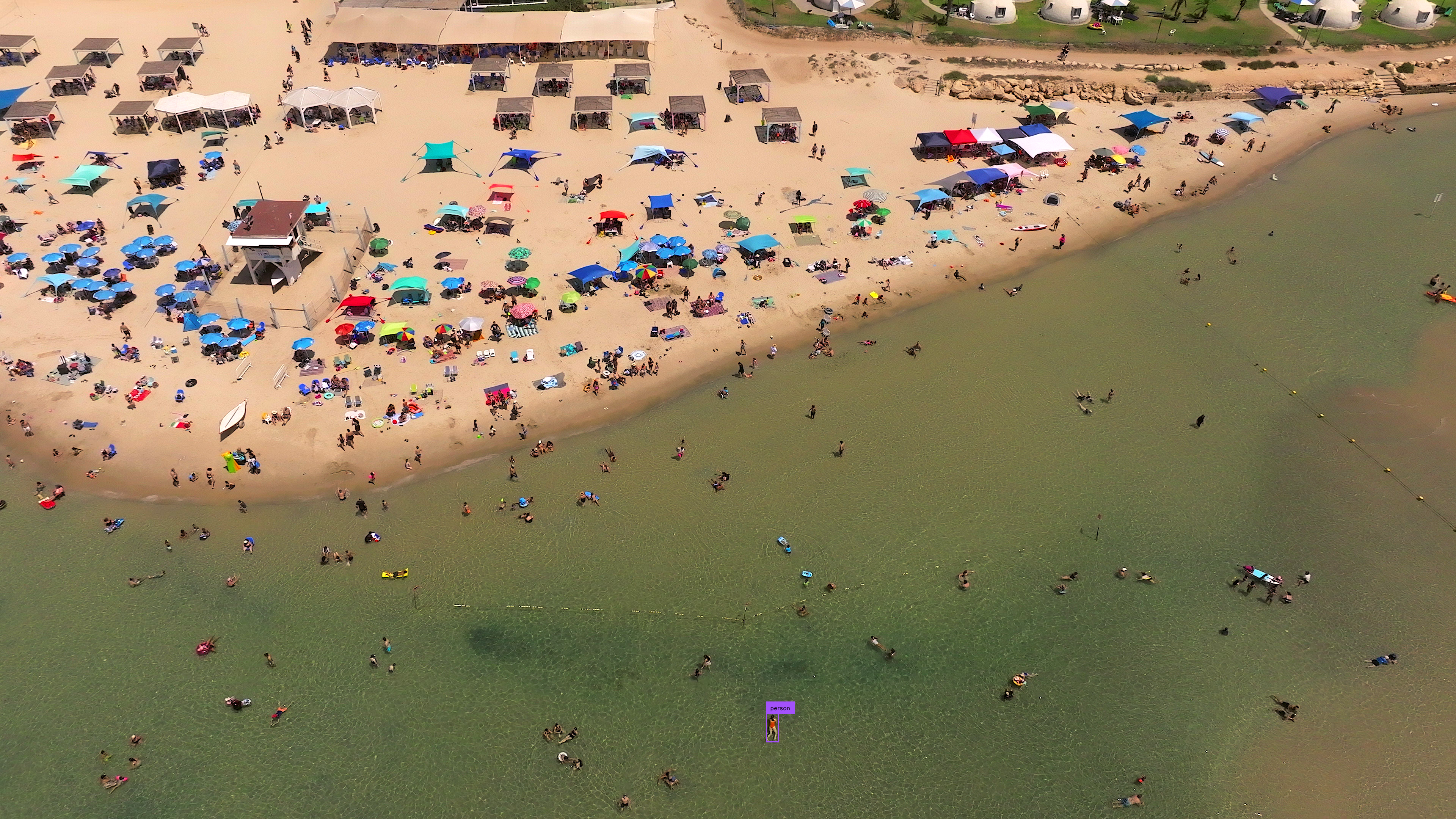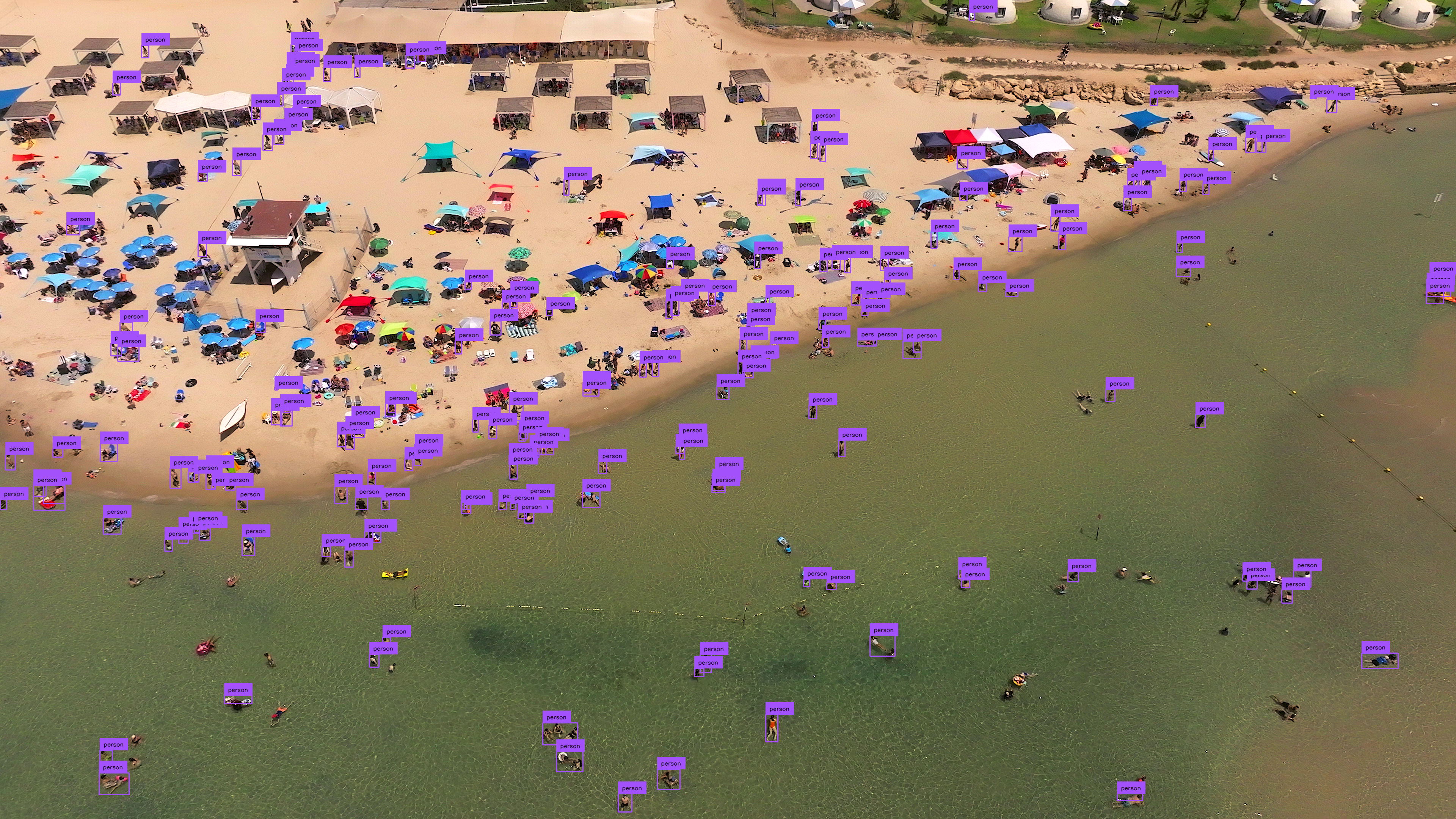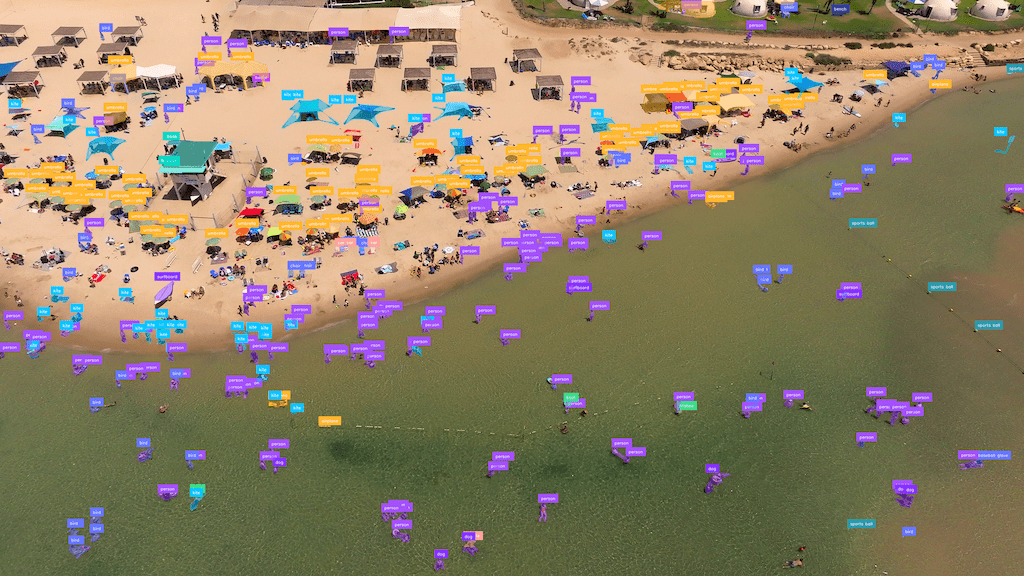Detect Small Objects¶
This guide shows how to detect small objects
with the Inference,
Ultralytics or
Transformers packages using
InferenceSlicer.
Baseline Detection¶
Small object detection in high-resolution images presents challenges due to the objects' size relative to the image resolution.
import cv2
import supervision as sv
from inference import get_model
model = get_model(model_id="yolov8x-640")
image = cv2.imread(<SOURCE_IMAGE_PATH>)
results = model.infer(image)[0]
detections = sv.Detections.from_inference(results)
box_annotator = sv.BoxAnnotator()
label_annotator = sv.LabelAnnotator()
annotated_image = box_annotator.annotate(
scene=image, detections=detections)
annotated_image = label_annotator.annotate(
scene=annotated_image, detections=detections)
import cv2
import supervision as sv
from ultralytics import YOLO
model = YOLO("yolov8x.pt")
image = cv2.imread(<SOURCE_IMAGE_PATH>)
results = model(image)[0]
detections = sv.Detections.from_ultralytics(results)
box_annotator = sv.BoxAnnotator()
label_annotator = sv.LabelAnnotator()
annotated_image = box_annotator.annotate(
scene=image, detections=detections)
annotated_image = label_annotator.annotate(
scene=annotated_image, detections=detections)
import torch
import supervision as sv
from PIL import Image
from transformers import DetrImageProcessor, DetrForSegmentation
processor = DetrImageProcessor.from_pretrained("facebook/detr-resnet-50")
model = DetrForSegmentation.from_pretrained("facebook/detr-resnet-50")
image = Image.open(<SOURCE_IMAGE_PATH>)
inputs = processor(images=image, return_tensors="pt")
with torch.no_grad():
outputs = model(**inputs)
width, height = image_slice.size
target_size = torch.tensor([[width, height]])
results = processor.post_process_object_detection(
outputs=outputs, target_sizes=target_size)[0]
detections = sv.Detections.from_transformers(results)
box_annotator = sv.BoxAnnotator()
label_annotator = sv.LabelAnnotator()
labels = [
model.config.id2label[class_id]
for class_id
in detections.class_id
]
annotated_image = box_annotator.annotate(
scene=image, detections=detections)
annotated_image = label_annotator.annotate(
scene=annotated_image, detections=detections, labels=labels)

Input Resolution¶
Modifying the input resolution of images before detection can enhance small object identification at the cost of processing speed and increased memory usage. This method is less effective for ultra-high-resolution images (4K and above).
import cv2
import supervision as sv
from inference import get_model
model = get_model(model_id="yolov8x-1280")
image = cv2.imread(<SOURCE_IMAGE_PATH>)
results = model.infer(image)[0]
detections = sv.Detections.from_inference(results)
box_annotator = sv.BoxAnnotator()
label_annotator = sv.LabelAnnotator()
annotated_image = box_annotator.annotate(
scene=image, detections=detections)
annotated_image = label_annotator.annotate(
scene=annotated_image, detections=detections)
import cv2
import supervision as sv
from ultralytics import YOLO
model = YOLO("yolov8x.pt")
image = cv2.imread(<SOURCE_IMAGE_PATH>)
results = model(image, imgsz=1280)[0]
detections = sv.Detections.from_ultralytics(results)
box_annotator = sv.BoxAnnotator()
label_annotator = sv.LabelAnnotator()
annotated_image = box_annotator.annotate(
scene=image, detections=detections)
annotated_image = label_annotator.annotate(
scene=annotated_image, detections=detections)

Inference Slicer¶
InferenceSlicer
processes high-resolution images by dividing them into smaller segments, detecting
objects within each, and aggregating the results.
import cv2
import numpy as np
import supervision as sv
from inference import get_model
model = get_model(model_id="yolov8x-640")
image = cv2.imread(<SOURCE_IMAGE_PATH>)
def callback(image_slice: np.ndarray) -> sv.Detections:
results = model.infer(image_slice)[0]
return sv.Detections.from_inference(results)
slicer = sv.InferenceSlicer(callback = callback)
detections = slicer(image)
box_annotator = sv.BoxAnnotator()
label_annotator = sv.LabelAnnotator()
annotated_image = box_annotator.annotate(
scene=image, detections=detections)
annotated_image = label_annotator.annotate(
scene=annotated_image, detections=detections)
import cv2
import numpy as np
import supervision as sv
from ultralytics import YOLO
model = YOLO("yolov8x.pt")
image = cv2.imread(<SOURCE_IMAGE_PATH>)
def callback(image_slice: np.ndarray) -> sv.Detections:
result = model(image_slice)[0]
return sv.Detections.from_ultralytics(result)
slicer = sv.InferenceSlicer(callback = callback)
detections = slicer(image)
box_annotator = sv.BoxAnnotator()
label_annotator = sv.LabelAnnotator()
annotated_image = box_annotator.annotate(
scene=image, detections=detections)
annotated_image = label_annotator.annotate(
scene=annotated_image, detections=detections)
import cv2
import torch
import numpy as np
import supervision as sv
from PIL import Image
from transformers import DetrImageProcessor, DetrForObjectDetection
processor = DetrImageProcessor.from_pretrained("facebook/detr-resnet-50")
model = DetrForObjectDetection.from_pretrained("facebook/detr-resnet-50")
image = cv2.imread(<SOURCE_IMAGE_PATH>)
def callback(image_slice: np.ndarray) -> sv.Detections:
image_slice = cv2.cvtColor(image_slice, cv2.COLOR_BGR2RGB)
image_slice = Image.fromarray(image_slice)
inputs = processor(images=image_slice, return_tensors="pt")
with torch.no_grad():
outputs = model(**inputs)
width, height = image_slice.size
target_size = torch.tensor([[width, height]])
results = processor.post_process_object_detection(
outputs=outputs, target_sizes=target_size)[0]
return sv.Detections.from_transformers(results)
slicer = sv.InferenceSlicer(callback = callback)
detections = slicer(image)
box_annotator = sv.BoxAnnotator()
label_annotator = sv.LabelAnnotator()
labels = [
model.config.id2label[class_id]
for class_id
in detections.class_id
]
annotated_image = box_annotator.annotate(
scene=image, detections=detections)
annotated_image = label_annotator.annotate(
scene=annotated_image, detections=detections, labels=labels)

Small Object Segmentation¶
InferenceSlicer can perform segmentation tasks too.
import cv2
import numpy as np
import supervision as sv
from inference import get_model
model = get_model(model_id="yolov8x-seg-640")
image = cv2.imread(<SOURCE_IMAGE_PATH>)
def callback(image_slice: np.ndarray) -> sv.Detections:
results = model.infer(image_slice)[0]
return sv.Detections.from_inference(results)
slicer = sv.InferenceSlicer(callback = callback)
detections = slicer(image)
mask_annotator = sv.MaskAnnotator()
label_annotator = sv.LabelAnnotator()
annotated_image = mask_annotator.annotate(
scene=image, detections=detections)
annotated_image = label_annotator.annotate(
scene=annotated_image, detections=detections)
import cv2
import numpy as np
import supervision as sv
from ultralytics import YOLO
model = YOLO("yolov8x-seg.pt")
image = cv2.imread(<SOURCE_IMAGE_PATH>)
def callback(image_slice: np.ndarray) -> sv.Detections:
result = model(image_slice)[0]
return sv.Detections.from_ultralytics(result)
slicer = sv.InferenceSlicer(callback = callback)
detections = slicer(image)
mask_annotator = sv.MaskAnnotator()
label_annotator = sv.LabelAnnotator()
annotated_image = mask_annotator.annotate(
scene=image, detections=detections)
annotated_image = label_annotator.annotate(
scene=annotated_image, detections=detections)
